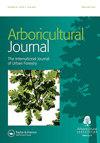Filling tree cavities with polyurethane foam adversely affects the accuracy of sonic tomography
Q3 Agricultural and Biological Sciences
引用次数: 1
Abstract
ABSTRACT Cavity filling has been frequently applied by arborists to urban trees over many decades. Polyurethane rigid foam was introduced to the arboricultural industry as a filling material to substitute for the concrete popularly used until the 1970s. However, cavity filling causes difficulties for tree inspectors in assessing and diagnosing internal tree defects using standard decay detection techniques. This study assessed the performance of two advanced wood decay detection techniques, sonic tomography, and resistance micro-drilling, by carrying out trials in detecting internal tree defects before and after they were filled with polyurethane foam. Ten hollow cross-sections cut from 10 separate trees were used in this study. Test results from resistance micro-drilling showed its performance was not significantly affected by the foam filling. In contrast, the sonic tomography exhibited a significantly weakened performance, consistently underestimating the extent of decay present in the cross-sections in the presence of the polyurethane foam filling, with acoustic wave travelling times reduced by 11% to 55% due to the treatment. We conclude that for foam-filled cavities, sonic tomography supplies a less reliable assessment of the internal decay present and that current best practice would be to rely on the accuracy of micro-drilling results instead.用聚氨酯泡沫填充树腔会影响超声层析成像的准确性
几十年来,树木学家经常将空腔填充应用于城市树木。直到20世纪70年代,聚氨酯硬质泡沫塑料作为填充材料被引入树木工业,以替代广泛使用的混凝土。然而,空腔填充给树木检查员使用标准的衰变检测技术评估和诊断树木内部缺陷带来了困难。本研究评估了两种先进的木材腐烂检测技术的性能,声波断层扫描和电阻微钻,通过在填充聚氨酯泡沫之前和之后进行检测树木内部缺陷的试验。在这项研究中使用了从10棵不同的树木上切下的10个空心横截面。阻力微钻试验结果表明,泡沫填充对其性能影响不大。相比之下,声波断层扫描表现出明显减弱的性能,在聚氨酯泡沫填充的情况下,声波断层扫描一直低估了截面上的衰减程度,由于处理,声波传播时间减少了11%至55%。我们得出的结论是,对于泡沫填充的空腔,声波断层扫描提供的内部衰减评估不太可靠,目前的最佳实践将依赖于微钻结果的准确性。
本文章由计算机程序翻译,如有差异,请以英文原文为准。
求助全文
约1分钟内获得全文
求助全文
来源期刊

Arboricultural Journal
Agricultural and Biological Sciences-Agronomy and Crop Science
CiteScore
2.40
自引率
0.00%
发文量
28
期刊介绍:
The Arboricultural Journal is published and issued free to members* of the Arboricultural Association. It contains valuable technical, research and scientific information about all aspects of arboriculture.
 求助内容:
求助内容: 应助结果提醒方式:
应助结果提醒方式:


